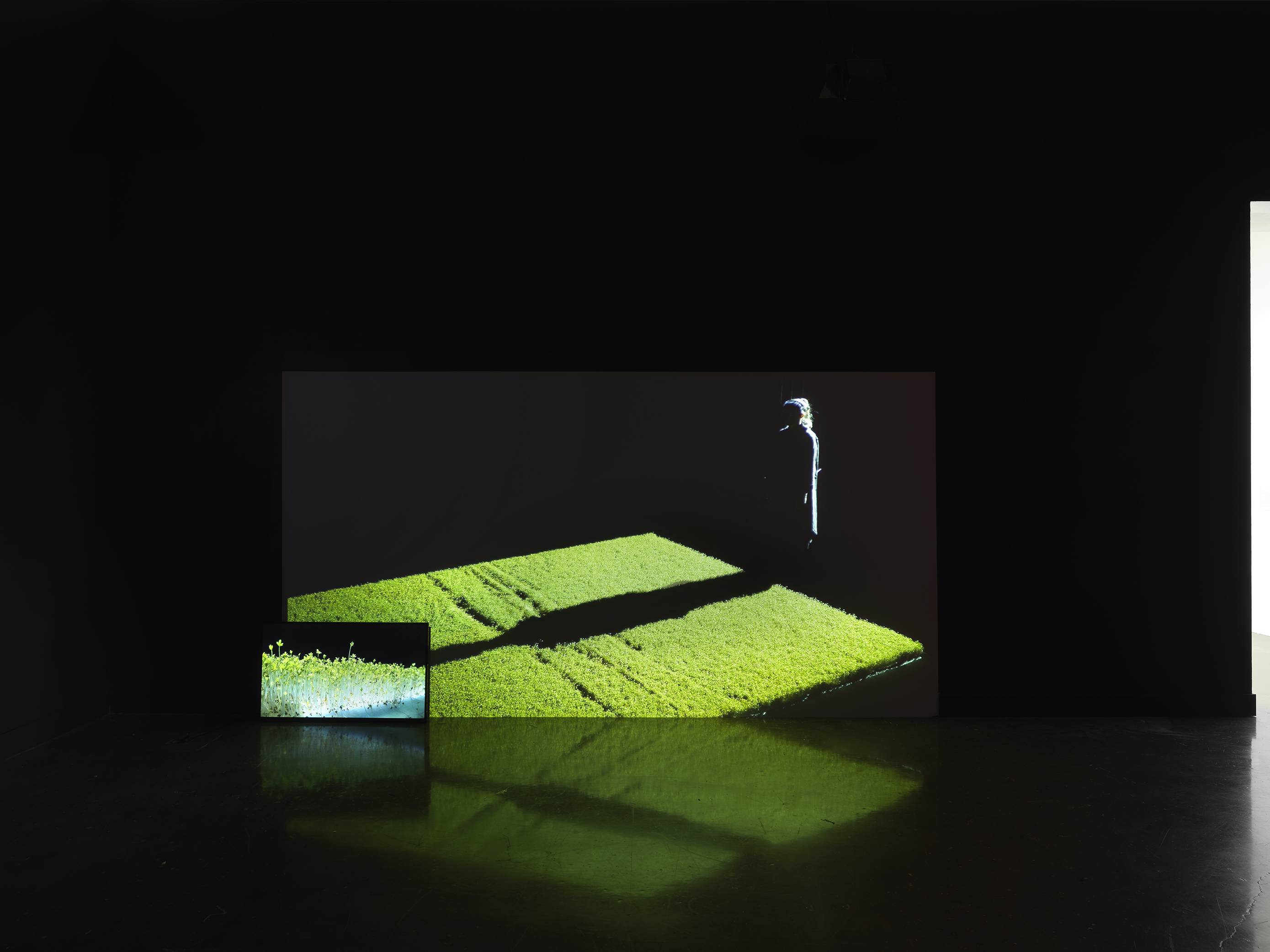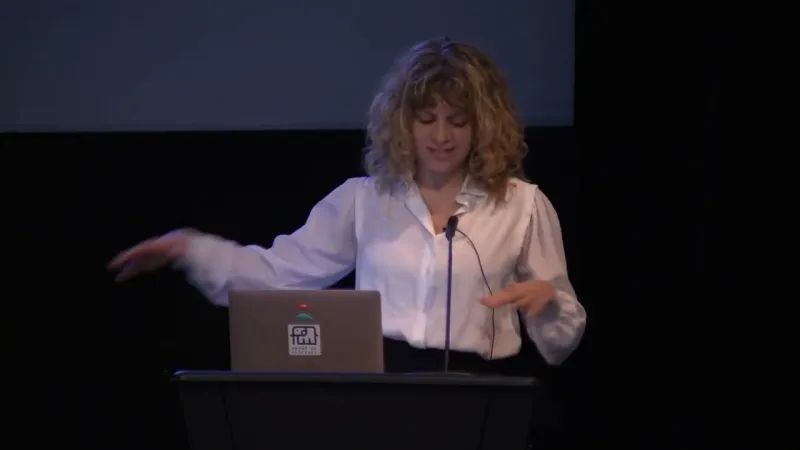Špela Petrič, Confronting Vegetal Otherness: Skotopoesis, 2015. Installation view: Symbionts: Contemporary Artists and the Biosphere, MIT List Visual Arts Center, Cambridge, 2022. Courtesy the artist. Photo: Dario Lasagni
Interspecies Attentiveness: An Artist Panel Discussion
Alan Michelson, Špela Petrič, and Miriam Simun, exhibiting artists in Symbionts: Contemporary Artists and the Biosphere, will convene in a panel discussion exploring interspecies communication and symbiosis.
Whether it is trees offering nectar to tempt bees (Simun), tobacco and its role in human ritual (Michelson), or plants and their gardeners (Petrič), many species engage with the vegetal and offer a form of what Petrič calls “vegetal consciousness.” Exhibition curators Natalie Bell and Caroline A. Jones will guide the discussion to explore human collaborations with varied species and the role of digital media and technologies in facilitating our exploration and pursuit of these ways of knowing, thinking, or communicating beyond the human.
To attend virtually, navigate to the livestream on Thursday, February 2 from 6–7:30 PM EDT. Video recording will with Closed Captions will be available at a later date.
Panelists
Alan Michelson is an internationally recognized New York-based artist, curator, writer, lecturer and Mohawk member of the Six Nations of the Grand River.
For over twenty-five years, he has been a leading practitioner of a socially engaged, critically aware, site-specific art grounded in local context and informed by the retrieval of repressed histories. Sourcing from both indigenous and western culture, he works in a varied range of media and materials, among them painting, sculpture, photography, sound, video, glass, and stone.
He is the recipient of several awards, including an NEA Visual Artists Fellowship, Native Arts and Cultures Foundation Artist Fellowship, and the GSA Design Award, Citation in Art. His work is in the permanent collections of the Whitney Museum of American Art, National Gallery of Canada, and the Smithsonian National Museum of the American Indian.
His practice includes public art, and Mantle, his large-scale monument honoring Virginia’s Indian nations, was recently dedicated on Capitol Square in Richmond. Michelson is co-founder and co-curator, with the Vera List Center for Art and Politics at the New School, of the Indigenous New York series.
Špela Petrič is a Ljubljana and Amsterdam based new media artist who has been trained in the natural sciences and holds a PhD in biology, currently working as a post-doc researcher at the Smart Hybrid Forms Lab at Vrije Universiteit Amsterdam. Her artistic practice combines the natural sciences, wet biomedia practices, performance, and critically examines the limits of anthropocentrism via multi-species endeavors. She envisions artistic experiments that enact strange relations to reveal the ontological and epistemological underpinnings of our (bio)technological societies. Her work revolves around the reconstruction and re-appropriation of scientific methodology in the context of cultural phenomena, while working towards an egalitarian and critical discourse between the professional and public spheres. Petrič received several awards, such as the White Aphroid for outstanding artistic achievement (Slovenia), the Bioart and Design Award (Netherlands), and an Award of Distinction at Prix Ars Electronica (Austria).
Miriam Simun works at the intersection of ecology, technology and the body, spanning multiple formats including video, performance, installation, writing, and communal sensorial experiences. Trained as a sociologist, Simun spends time in communities of experts, ranging from biomedical engineers to breastfeeding mothers. Taking on the role of ‘artist-as-fieldworker,’ much of the process is rooted in research as lived experience, forefronting corporeal and sensorial ways of listening, learning and knowing. The resulting works are concerned with the collision of bodies (human and non) with rapidly evolving techno-ecosystems. If collision can be understood to be a form of disturbance (in the ecological sense), then in disturbance we move through damage to an opportunity for renewal. Simun’s work explores the vital role our sensorial experiences play in enabling, engaging and making renewal.
Simun’s work has been presented internationally, including Gropius Bau in Berlin, New Museum in New York, Himalayas Museum in Shanghai, Momenta Biennale in Montreal, The Contemporary in Baltimore, Bogota Museum of Modern Art in Bogota, Ronald Feldman Fine Arts inNew York, Museum of Fine Arts, Museum of Arts and Design in New York, Robert Rauschenberg Gallery in New York, and the Beall Center for Art + Technology in California. Simun is a recipient of awards from Creative Capital, Robert Rauschenberg Foundation, Joan Mitchell Foundation, Foundation for Contemporary Arts, as well as a 2022 La Becque Artist-in-Resident, 2021 Onassis Foundation fellow, a 2019 Gulbenkian / Carpintarias de São Lázaro Artist-in-Residence, a 2018 Visual Arts residency at the Headlands Center for the Arts, a 2016 Artist Residency with OMI International Arts Center in New York, a 2015 Food Justice Residency at the Santa Fe Art Institute, and a 2014 Art Professionals in Athens residency in Greece. Simun’s work has been recognized internationally in publications including the BBC, The New York Times, The New Yorker, CBC, MTV, Forbes, Art21, and ARTNews. Simun is a graduate of the MIT Media Lab, ITP at NYU Tisch School for the Arts and the London School of Economics and Political Science.
Moderators
Natalie Bell is a curator at the MIT List Visual Arts Center, where she recently organized exhibitions of Leslie Thornton, Matthew Angelo Harrison, Raymond Boisjoly, and Sreshta Rit Premnath and co-curated Symbionts with Caroline A. Jones and Selby Nimrod. While at the New Museum, she co-curated several major group exhibitions. Including The Warmth of Other Suns(2019), Trigger: Gender as a Tool and a Weapon (2017), The Keeper (2016), and Here and Elsewhere (2014). Bell has edited or co-edited more than a dozen exhibition publications widely.
Caroline A. Jones is Professor in the History, Theory, Criticism section of the Department of Architecture, also serving as Associate Dean for Strategic Initiatives in the School of Architecture and Planning at MIT. She studies modern and contemporary art, with a particular focus on its technological modes of production, distribution, and reception, and on its interface with sciences such as physics, neuroscience, and biology. Her essays on modern and contemporary art have appeared in journals ranging from Artforum to Critical Inquiry to Science in Context; she is solo author of several books and exhibition catalogues, and a co-editor of volumes that examine technology and the senses, art and neuroscience, and art history and history of science as parallel inquiries. Collaborative work with historian of science and physicist Peter L. Galison will culminate in a book on scientific and viral images of environmental harm, titled Invisibilities: Seeing and Unseeing the Anthropocene (forthcoming with Zone Books at Princeton University press). Her research has been supported with fellowships from the Guggenheim Foundation, the National Humanities Center, the Institute for Advanced Studies, the Radcliffe Institute, the Wissenschaftskolleg zu Berlin, the Max Planck Institute, the National Endowment for the Humanities, the Social Science Research Council, and other foundations interested in interdisciplinary inquiry emerging from art history. Jones was part of the curatorial team for Symbionts: Contemporary Artists and the Biosphere, accompanied by a publication from MIT Press, October 2022.




